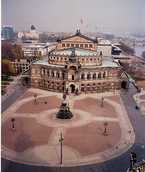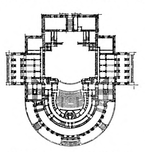Semper Opera House
Gottfried Semper
alias Königliches Opernhaus, Stadttheater, Altstädter Hoftheater, Opernhaus, Sächsische Staatsoper, SemperoperaTheaterplatz 2, | |
| show on the map | http://www.semperoper.de/ |
Important events
People
History
The first theatre
Semper's first major work, the Dresden Opera House of 1838—41, at once launched a new theatrical type. The facade consisted of a two-storeyed semi-circular loggia (Doric and Ionic), with the higher auditorium, also semi-circular, set back behind it and articulated with Corinthian pilasters. The plan clearly leaned heavily upon the French theorists of the eighteenth century—Durand and his school—and in particular upon a late Italian member of it, Pietro Sangiorgio, whose Idea di un teatro of 1821 works out the implications of the semi-circular front and side entrances in some detail. Semper's own philosophy is best expressed in a description he wrote of a later project, the Rio de Janeiro opera house : 'Above all I have wished not to conceal the semi-cylindrical form of the auditorium, a form beautiful and varied in itself, and sanctioned moreover by theatrical tradition. I have not imprisoned it in a square cage, as most modern auditoria are.' At Dresden one could enter through the centre of the facade into the semi-circular vestibule, but the main staircases were at the sides, entered by way of separate lateral porches. The high roof of the auditorium was extended sideways over these porches, like the transepts of a cathedral. The auditorium, in deference to contemporary usage, was in fact not semi-circular but horseshoe-shaped. Gottfried Semper's facade of the Dresden Opera House revealed the semi-cylinder of the auditorium for the first time since antiquity, though it had been advocated in several eighteenth-century ideal projects. With its semi-circular foyers on two levels and staircases in 'transept positions at the sides, this design was to prove influential for the next hundred years.
The second theatre
The Paris Opera was naturally imitated in other cities, but it was not the only model. Its rival was the type evolved by Semper at Dresden. The differences between the two were not so much in the stage-auditorium complex as in the grouping of the subsidiary rooms and staircases. The French type favoured a straight front, with the main foyer occupying the first floor, and a central grand staircase behind, leading into the back of the auditorium. The German preferred the curved facade, with its curved vestibule behind, which involved banishing the staircases to the 'transept' position. Many architects followed Gilly in combining a pedimented entrance a la Schinkel with curved sides leading back to straight wings. Semper himself used this form in his second Dresden Opera House, built after the first had burnt down in 1869. He also modified the semicircle of the earlier theatre to a segmental curve, a form we have seen used in certain eighteenth-century theatres, though rarely expressed on the exterior. The Hofburgtheater of Vienna, begun in 1874 by Semper, assisted by the young Karl von Hasenauer, follows the same plan, with the 'transept' staircases here expanded into extremely grand architectural compositions, deliberately challenging Garnier. This plan was criticised because it 'was confessedly based upon plans for opera houses, and consequently the architectural principles involved in carrying it out satisfy operatic rather than dramatic requirements.' It was a criticism that could be levelled at many large theatres of the time, where grandeur had priority over function. Nevertheless, Semper's influence continued well into the twentieth century.
In: Tidworth, Simon : Theatres: An Illustrated History. London 1973 p. 156 -156 , 164 - 165
Author: Simon Tidworth
Simon Tidworth:
religious structures, Palais Garnier, Théâtre du Vieux-Colombier, Semper Opera House, Teatro alla Scala, Verona Philharmonic Theatre, Teatro El Buen Retiro, Malmö Municipal Theatre, People's Theatre, National Opera of Bordeaux, Musical Theatre of Besançon, Opernhaus auf der Cortina, Theatre Royal, The London Coliseum, Opernhaus in Salvatorplatz, Stuttgart State OperaAdditional information
No information has yet been entered
Add information























